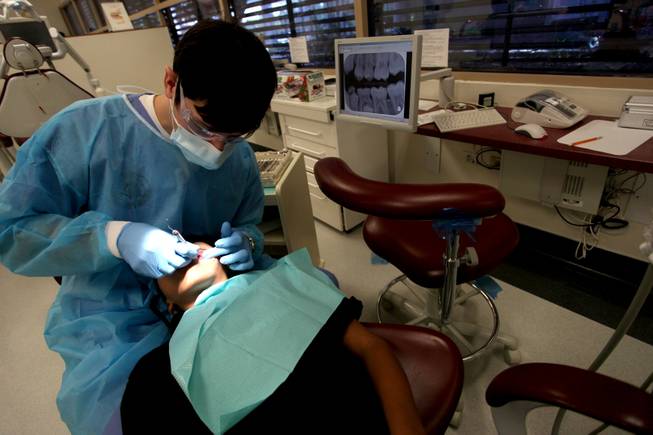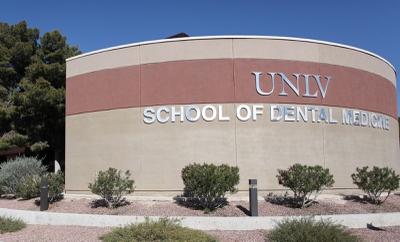
Shea Hart, a second-year dental student, works on Aaron Wrencher as the UNLV Dental School of Medicine faculty and students put on three clinics to treat local children, veterans, and women referred by Shade Tree Shelter.
Wednesday, Dec. 19, 2012 | 2 a.m.

The UNLV Dental School of Medicine faculty and students put on three clinics Saturday to treat local children, veterans, and women referred by Shade Tree Shelter. The clinics are designed for people who do not qualify for Medicaid or are uninsured. The event also provides UNLV dental residents with clinical experience.
Sun coverage
The UNLV School of Dental Medicine is one of 11 schools nationwide chosen to partner with the American Dental Education Association on a program to encourage minority students to enter dentistry.
The school will receive a $12,000 grant for the yearlong initiative, and administrators and faculty will be able to attend a three-day training course covering the association’s lessons from a decade-long project looking into expanding dental care to underserved populations.
The association’s Pacific Dugoni Dental Pipeline National Learning Institute is a new training program dedicated to increasing recruitment and retention among low-income and underrepresented minority students at dental schools. The goal is to generate a diverse workforce of dentists who understand the oral health care needs of patients from underserved populations.
Each participating university will partner with a group or organization to develop better pathways for minorities into dental programs.
“Dentistry is similar to medicine in that the research shows that a health workforce that is more diverse is more prepared to serve a diverse community,” said Kim D'Abreu, ADEA senior vice president for access, diversity and inclusion. “There’s lots of data and research to support that practitioners of color treat patients of color in a disproportionate amount. With a more diverse workforce, there is more access to care for underserved and diverse patient populations.”
Language barriers and cultural differences are just two examples of obstacles to better patient care that a more diverse workforce could help address, D’Abreu said.
On average, 12 percent of students at U.S. dental schools are from underrepresented groups such as blacks, Hispanics and Native Americans. The average is skewed somewhat by historically black colleges and dental schools in Puerto Rico that have much higher percentages of minority enrollment, D’Abreu said.
At UNLV, approximately 10 percent of dental students are from underrepresented populations, according to Karen West, dean of the UNLV School of Dental Medicine.
“We’ve seen an increase in diversity in our class recently, and the numbers were very low originally,” West said. “We’ve seen an increase in Hispanic and African-American student applications and even some more Native American applicants. Quite honestly, we want the statistics at the school to mirror the population of Las Vegas.”
At UNLV, the dental school will partner with the Center for Academic Enrichment and Outreach to provide programs for high school students interested in the so-called STEM fields: science, technology, engineering and math. Those programs will expose the students to career possibilities in medicine, including dentistry.
The center offers the Upward Bound Math and Science program, an academic enrichment program for area high school students that helps develop math and science skills.
Students in the Upward Bound program will be invited to an outreach event where they can explore various careers in medicine, including dentistry. There also will be hands-on activities that will demonstrate what dentists do on a daily basis, according to Mildred McClain, assistant professor of clinical sciences at UNLV and one of the project coordinators. Students also will be provided with career mentors and will be advised about academic requirements in their chosen medical field.
The dental school also is partnering with College of Southern Nevada, the UNLV Office of Academic and Student Affairs, and other local organizations.
The project is being run through the University of the Pacific Arthur A. Dugoni School of Dentistry and is funded by a grant from the Robert Wood Johnson Foundation.
After the 12-month program ends, the dental school would like to apply for a larger grant from Robert Wood Johnson to keep the initiative going, McLain said.
The program is the next phase of the Dental Pipeline, an initiative started in 2002 and funded by Robert Wood Johnson to explore ways to expand the reach of dental care through dental schools and their clinics. Lessons learned from that program, which involved 22 dental schools, are now being applied through the Dental Pipeline National Learning Institute.
Many dental patients in Southern Nevada who are low-income or do not have insurance already make their way to UNLV’s dental clinic, where prices are typically lower, West said.
“Dental Care has long been seen as luxury for people,” West said. “Because of that … it’s often one of the last priorities for health care. But we know that there are more absences from school for children because of toothaches than anything else. We have to get the word out there that oral health is part of total health, and is just as important or more important than other areas.”

Join the Discussion:
Check this out for a full explanation of our conversion to the LiveFyre commenting system and instructions on how to sign up for an account.
Full comments policy